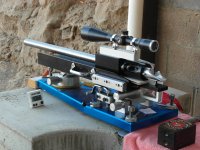I've seen a few photos of rail guns where the action was mounted in the block and not the barrel
The first one pictured belonged to Frank Murphy, and the second and third look like they were made by Jay Young, the fourth one was built by Mike Bryant and the third & sixth one look like long Stolle actions bolted to the top.
I assume these shot pretty well, or did they? The reason I ask is because I still see more barrel block rails compared to action block rails.
The first one pictured belonged to Frank Murphy, and the second and third look like they were made by Jay Young, the fourth one was built by Mike Bryant and the third & sixth one look like long Stolle actions bolted to the top.
I assume these shot pretty well, or did they? The reason I ask is because I still see more barrel block rails compared to action block rails.
Attachments
Last edited:







